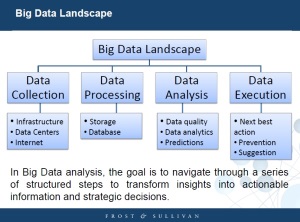by Frost & Sullivan Energy & Environment Research Analyst Aanchal Singh — Carly Fiorina, former chief executive of Hewlett-Packard once said, “The goal is to turn data into information, and information into insight.” Analysis indicates that in recent years as energy management has become a center point for facilities managers, storing and utilizing massive data sets is capturing attention. The concept is simple, but the value and size of this data goes beyond the capabilities of typical database software tools. This is where “Big Data Analytics” come in.

Big Data can generate numerous opportunities in terms of complete energy solutions, business value, and optimum customer service satisfaction in any facility. Facility managers must leverage the entire plethora of collected data to make this possible. Hence, the idea is to create a structured way to collect, process, and analyze a set of data to better performance and increase functional capabilities of the facility.
Big Data can create value
With increased sophistication of systems within facilities, consistent maintenance is required. Some of the major challenges facing facility and energy managers are:
- Non-Effective energy metrics
- Disparate systems
- Lack of effective energy management systems
- Lack of performance visibility
These challenges negatively impact a facility’s operational efficiency, however Big Data can rescue many facilities from such fall-outs as datasets easily identify current operational complexities and drive improved decision making.
I recommend Big Data analytics as a solution to myriad of problems in buildings. Decision making becomes easier if we have a set of data collected through surveys, smart meters, IT networks, and occupant behavior. Precise research and analysis can convert collected information into operational insights for:
- Detecting future power outages or equipment failure
Use of data analytics can help deploy a meaningful forecast to fix power outages and failures. This can be achieved with the help of integrated systems within a facility. These systems enhance interoperability so that data can be more readily shared across different parts of the facility and can be used to fix a specific problem.
Take, for example, demand response and sensors in lighting. Outdated street lights have been replaced by LED luminaries which contain data gathering sensors. Utility companies can use the captured data to develop a precise analysis of failures or to identify ways to lower energy costs.
- Benchmarking facilities for comparison of energy consumption patterns and waste
Facilities can also achieve greater efficiency through data comparisons. By comparing the power of one facility to those of others, managers can conceptualize a way to reduce waste and increase efficiency.
- Managing buildings’ performance
Big Data can unlock significant value by making related information transparent and accurate. Given that energy usage is not constant, facilities using smart sensors or smart meters can easily access data and spit out solutions that enable facilities and customers to shift any non-essential electricity or energy to non-peak hours.
Facilities can also leverage Big Data for energy savings and to optimize building performance. Facility mangers can rely on building management systems (BMS) deployed across multiples sites with up-to-date information and data. With the growth of smart sensors and the Big Data that they produce, facilities can have instant visibility to crunch that information.
Big Data is diversified
In green building practices and design, the focus is primarily on reducing energy costs and cutting down greenhouse gas emissions. We cannot possibly reduce energy costs if we do not understand them. It is important for construction, facility management companies and end-users to think of what’s being wasted in the first place. What are the challenges to energy efficiency? Where can future investments be made? Once we gather data metrics pertaining to these questions, we can create very powerful solutions to energy challenges.
Additionally, analysis indicates that characteristics of LEED and BOMA certified building are also associated with Big Data analytics. Some of these characteristics are Energy Star labels, sustainable materials, and solar purchases. Hence, when data points derived from the above mentioned attributes come together, they can identify varying degrees of information. This information helps managers analyze performance, operational costs and savings, tenant retention plans, historical metrics. It is quite spectacular that data collected from one attribute can prove so beneficial in comprehending the results of the others.
Commercial building management not only uses data analytics to identify energy saving opportunities, they also want to lower the costs of energy audits. Virtual energy audits are made possible by the ease of Big Data analytics. Companies and buildings can easily access data to show the impact of occupant electricity loads, energy consumption patterns, interval and daily usage profiles, occupied floor plans and weather data. Making low cost operational changes through virtual audits and Big Data can double energy efficiency in commercial buildings. Leveraging Big Data will help intelligent buildings better understand energy trends and what future investments can be made towards tools to unleash the power of Big Data.
Conclusion: Evolution has not stopped!
The world of Big Data is growing and exponentially expanding. The Big Data universe will change according to complexities of the market. By learning from historical data and using contemporary technological capabilities, facilities can gain meaningful insights to derive unique opportunities to make creative and efficient decisions that will have a long lasting impact.